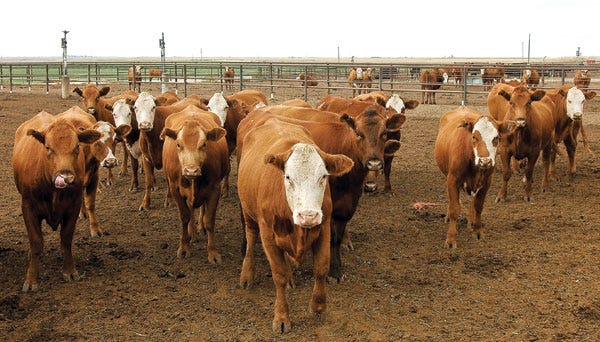"Basically, a feedyard offers constant care for a rancher’s cows. Feedyards have the ability to handle and deliver quantities of feed that a rancher may not be able to handle.” -- Ted McCollum
January 12, 2012

 The drought of 2011 has turned many Southern Plains ranches into deserts, leaving some producers no choice but to cull their herds and flood auction sales and packing plants with a steady stream of open and bred cows and heifers. But Frontera Feedyard, Muleshoe, TX, is helping ease the pain.
The drought of 2011 has turned many Southern Plains ranches into deserts, leaving some producers no choice but to cull their herds and flood auction sales and packing plants with a steady stream of open and bred cows and heifers. But Frontera Feedyard, Muleshoe, TX, is helping ease the pain.
It’s among a handful of feedyards providing a few pens for cow maintenance programs. And while it’s a service that some ranchers have taken advantage of, it’s only a “very small portion” of the several million cattle on feed in the Texas, Oklahoma and New Mexico region, says Don Close, Texas Cattle Feeders Association director of marketing.
Frontera, a 35,000-head capacity custom feedyard, had about 1,000 bred first-calf heifers in its pens in the fall. There were also some 400 bred and open cows and bulls at the facility, which normally takes 500-800-lb. steers and heifers and finishes them out to 1,200-1,400 lbs. via a high-energy ration.
“These ranch cattle, however, are on a special maintenance ration that’s helping them regain their strength and body condition score,” says Jeff Matsler, Frontera manager.
“With this drought, many ranches just didn’t have the grass or stock water. But we’re able to take cows and heifers, bred or not, and have them on this program for about 75 days. Cows will then return to the ranch, be sold to other ranches by video sale, or be sent to a packer.”
Located just an alley or two away from pens of Angus and crossbred steers that will likely grade close to 70% Choice, the “warehouse” pens contain all breeds and types of cattle. Some, having been through weeks of 100°F-plus days and no rainfall, may think a feedyard is nirvana when they walk off the truck. Condition ratings probably average a body condition score 3 at best.
“Some cows were so thin that it took a lot to get to an adequate flesh condition,” Matsler says.
Maintenance ration
Matsler says the initial cow or bred-heifer ration consists of about 40% sorghum silage, 40% cotton burrs, 16% steam-flaked corn and a supplement.
“Once the cattle are well along in the program, we switch to about a 40% corn ration with less forage,” he says.
Part of the feeding package includes a blood-test pregnancy check from the yard’s consulting veterinarian. At the rancher’s discretion, open cows would be sold and shipped to Caviness Packing Co., a regional processor that’s seen an enormous cow-slaughter run since last spring.
Meanwhile, bred cows and first-calf heifers would remain on feed to defer use of available forage on the ranch or until ranch pastures produce some grass from eventual rains.
Such a program is an alternative for ranchers who may want to feed their cowherds in the absence of grass, says Ted McCollum, Texas AgriLife Extension livestock specialist based in Amarillo.
“Basically, a feedyard offers constant care for a rancher’s cows,” he says. “Feedyards have the ability to handle and deliver quantities of feed that a rancher may not be able to handle.”
They can also locate the feed via a network of commodity brokers. That’s been a common complaint among ranchers, whether or not they can find cotton burrs or hay.
“Feedyards can do that, and always have someone checking the cattle and delivering feed,” McCollum says.
Matsler and his associates assist herd owners in evaluating their options for the calves – ship them home, sell to the feedyard or someone else, or leave them at the feedyard under a retained-ownership program.
“Most older cows wind up going to the packer,” Matsler says. “But most bred heifers will go back to their original ranch. Producers have put a lot into their herd genetics and realize it will be difficult to replace those animals with the same type of quality.”
Rebuilding costs will be high
With the massive liquidation of cows due to the drought, projections are that bred-cow and bred-heifer prices will be high next spring when ranchers seek to rebuild.
“Some estimate that bred cows will be worth $1,800 to $2,000,” Matsler says. “This program is an alternative to selling now and replacing later at a higher price.”
For example, it costs $2 to $2.50/day to keep the animal in the “warehouse” program. It will likely be at the feedyard from 60-90 days, with an average of 75 days. “Overall costs will be about $300/cow or bred heifer,” Matsler says.
McCollum says some ranchers will likely leave cows in the feedyard up to 120 days, depending on their overall condition and the availability of pasture.
“Most feedlots have the ability to shift feeding abilities to put flesh on cows,” he says. “They can set up a nutritional program to maintain the cows as long as it takes. Ranchers can then save what grass they have and have something to take the cows home to in late winter or spring.”
Matsler says the security offered to ranchers by the feedyard is welcomed, especially from producers who have never dealt with a feedyard in the past. “They like that someone is looking after their cattle 24 hours a day,” he says.
Larry Stalcup is an Amarillo, TX-based freelance writer.
You May Also Like



